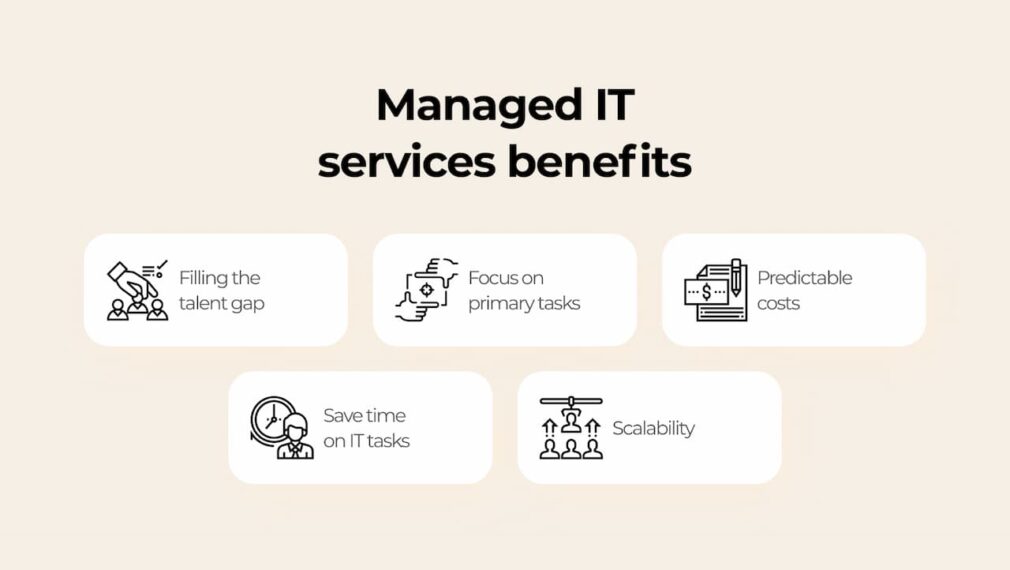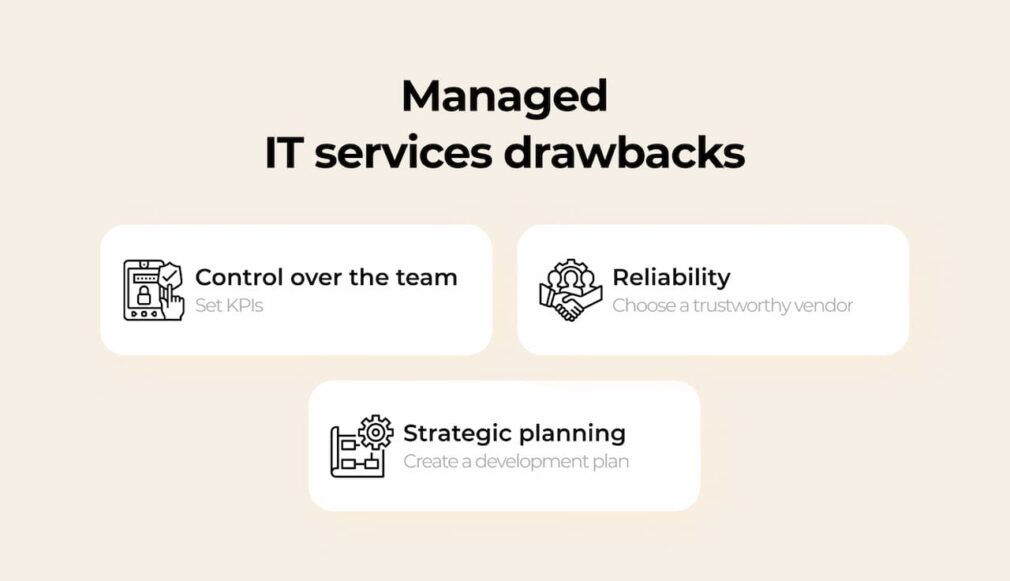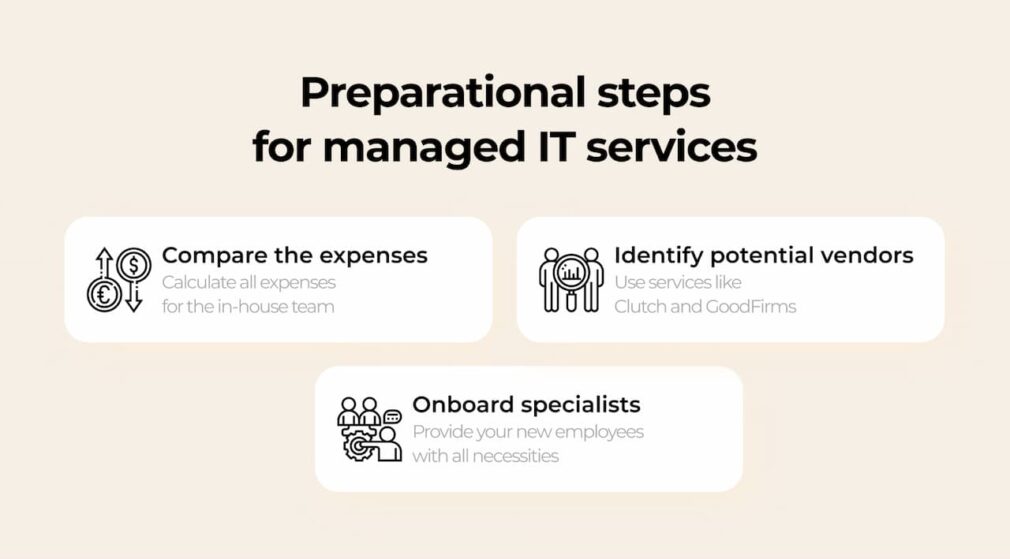The wide range of up-to-date solutions offered by the IT market requires various teams, such as developers, quality assurance engineers, and designers. Another expert who provides qualitative and efficient services to develop the above-mentioned solutions is DevOps. This specialist synchronizes all the building stages of the product, maintains and updates the software, and supports the platform users to guarantee a high-security level.
Hiring competent DevOps experts for the in-house team is a pretty difficult task since they are scarce and have rare specialization with quite costly services. Therefore, the most practical and efficient option is to apply to outsourcing specialists who will take over IT business operations.
Such conditions are beneficial because there is no need for hiring and payments are made only based on work results. Moreover, managed services are rising in popularity nowadays. Statista claims that this field surmounted a market share of $200 billion in 2020 and is expected to cross $300 billion by 2025.
This article will cover the managed IT services notion, its types, advantages, and pitfalls.
What are Managed IT Services?
This type of service aims at providing the users with an opportunity to operate and control network and server equipment, regulate cloud services and maintain software.
In a nutshell, managed IT services allow the team to concentrate on the significant objectives. However, small or medium companies neglect taking advantage of private clouds by deploying physical servers comprising data, software, IDEs, and other elements. Server maintenance requires new team members. In case the server fails, customers can’t receive the goods/services and are left dissatisfied.
Managed IT systems are able to overcome such obstacles by accomplishing all the IT processes in a private cloud. Such large cloud providers as Amazon S3 provide faultless servers with potent hardware. If clients face any problems, they are able to receive consultation from an IT managed service provider.
Tasks of Managed Services in IT
Entrusting IT management to third-party services offers beneficial value for money and high performance if you apply to outsource.
You can get acquainted with all the tasks of IT managed services below:
Data Backup
Such a widespread issue as cyberattacks requires data backups. In case your business is based on data, the lack of backups may inflict damage and profit loss.
IT managed services provide automatic backups and data transfer to reserve machines to cope with any possible failures. The server may operate on-premise or in the cloud. Tech-savvy specialists maintain a physical server or cloud architecture, manage data, control databases, and fulfill other related aims.
Analysis and Consulting
Newly-established organizations often outsource performance analysis due to insufficient competency in cloud infrastructure management and system execution evaluation.
These duties are usually accomplished by DevOps engineers, who conduct system analysis to make up a list of enhancing suggestions. In-house specialists use it for system development. As a result, you achieve both high system efficiency and low outgoings due to a reduced amount of resources (AWS involvement).
CI/CD Regulating
Continuous integration/continuous delivery is a set of actions to help automate the software delivery process. It may be described as a performing specification comprising all measures fulfilled by developers. The aim is to provide the updated version of the product for higher efficiency. Therefore, there’s no need for programmers to create and test the platform manually. These responsibilities are taken over by CI/CD.
The pipeline of IT managed services is adjusted due to your requirements. For instance, such languages as C/C+ or Java require the development of a software instance for later work. Wherein languages like JavaScript or Ruby are able to skip this step. So the pipeline’s flexibility may be adapted by outsourced experts to satisfy your needs.
Cloud Infrastructure Security
Security is a vital point when it comes to cloud app development. The widely used cloud service provider is Amazon, with a shared responsibility model: AWS keeps the entire cloud safe, whereas users secure the resources and applications inside. Thus, hardware, software, and network operated by AWS service are secured by Amazon. Nevertheless, the protection of the stored elements lies on users’ shoulders.
Managed IT service vendors utilize AWS frameworks (like Identity Access Management , S3 security, CloudTrail) to secure the customers’ software from fraudulent actions.
Advantages of Managed Services in IT
Let’s proceed to the benefits of IT management services and why they may be profitable for you.

Talented Partners
The significant pros of outsourcing are that demanded executive and proficient specialists are already hired. The recruitment process is time-consuming and requires covering specific details.
However, these obstacles are overcome by the managed IT service provider who connects you to the required expert. To choose the best partner for profitable cooperation, you should collect and analyze the info about managed IT vendors, such as reviews and rates. These points are available on platforms like Clutch and GoodFirms.
Focus on Major Tasks
The initial objectives should be prioritized to make your business successful. In this case, managed IT service allows focusing on significant tasks. Software developers are usually responsible for server deployment and installation of cloud storage when it comes to startups. The amount of duties is too big, which leads to the employees’ burnout. Managed IT services cope with this issue.
In addition, business owners may receive valuable recommendations on IT processes. Consequently, qualified DevOps services may significantly enhance your business IT operations with competent tech suggestions.
Predictable Costs
Another benefit is the opportunity to calculate the final paycheck for the IT services in advance. As a result, you may conveniently manage your outgoings.
What’s more, vendors offer various payment plans (e.g., hourly rate/monthly payment). Another option is paying for certain tasks. So the payment plan may also be adapted for your requirements, which is also quite beneficial.
Less Development Time
A bigger number of experts can develop, test, and release the product faster and avoid fatigue. The time-efficient launching allows us to assess the product’s performance in a real environment and fix all the bugs (if any). With the help of managed IT services, the in-house team will meet all the deadlines without working over and feeling exhausted.
Scalability
The enterprise’s progress impacts the growth of the team. DevOps department maintains servers, protects the cloud framework, and adapts cloud services.
On the other hand, on-demand hiring conditions provide you with reliable experts immediately. You may invite the employee from the outsourcing company to work in your office, which will also decrease your expenditures.
Challenges of IT Managed Services
Here’s the list of main drawbacks of these services which you also have to note:

Team Management
Some unfair vendors may use your guiding inaccessibility and provide specialists who will fulfill tasks slower to make the customer pay more.
To prevent dishonesty, you should define certain KPIs to your partners from abroad and discuss defined deadlines and the delivery of the final product.
Credibility
To choose a suitable company, you should explore as much information about it as possible. Check the clients’ reviews on the cooperation experience on verified sources, like Clutch. GoodFirms is another source that provides reports on heading companies from diverse niches and contains all the essential data.
Strategic Approach
The most suitable specialists can only be selected based on clearly stated requirements, which you set during the negotiation with the vendor. Therefore, you will be delighted with the final result.
From the perspective of the scalable approach, you will benefit from having the vision of the project’s future for a couple of years forward.
Managed Services: Primary Steps
Last but not least: let’s cover the beforehand actions to utilize managed services successfully.

Calculate the Expenditures
You should begin with an entire cost calculation of an in-house DevOps team, which has to incorporate the average team members’ salary with the extra outgoings like insurance, vacation, etc. Please note that, commonly, in-house developers can cope with all the tasks alone in moderate projects. In this case, negotiating the conditions, setting requirements, and signing up contracts may be time-consuming.
However, if your project is large-scale and requires complex and sophisticated solutions, you will be pleasantly surprised by managed IT services pricing, and that will help you to benefit financially. The saved effort and finances may be invested in the creation of your project.
Select Potential Partners
After filtering all the options of potential vendors, you should select the most suitable ones. Then, you should compare them and weigh the pros and cons of each company.
For productive and clear communication, you should look for partners who can speak English fluently. Otherwise, constant misunderstanding will affect the cooperation efficiency. Moreover, the primary point to consider is payment conditions, so you should discuss them in detail.
Choose a Provider and Onboard Specialists
After contacting the chosen vendor, you should arrange a meeting to thoroughly and properly describe your requirements for the final product. The type of your project will identify your future steps. For instance, if your aim is to move from physical servers to the cloud, the vendor will ask you to ensure the utmost access stage to the server and cloud-provider accounts.
After that, the vendor defines the most suitable specialists with relevant expertise personally for you. You may explore their CVs and interview each one to make a correct decision. In case your computing knowledge is insufficient, you may ask your senior developer to help you.
Eventually, after hiring all the essential teammates, you should onboard and introduce your project to them. The team should access all the project management tools, server architecture data, and communication services like corporate chats. Furthermore, you should keep in touch with your employees so that they can reach out to you to clarify any arising questions. Needless to say, you should introduce your new employees to your in-house team.
Wrapping Up
IT managed services are highly advantageous for a business and may help to overcome lots of issues and obstacles. Such work is complex, versatile, and has certain peculiarities. Your partner is provided with access to vitally significant data and processes, which require great expertise and a high level of reliability. Owing to these facts, the main factor is to choose a trustworthy and competent partner carefully and meticulously. So the performance and qualification level are key points to consider. This way, the cooperation will be beneficial and productive for your business.